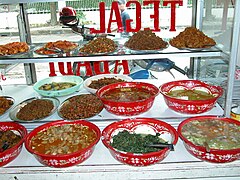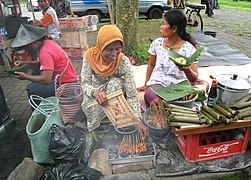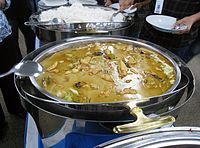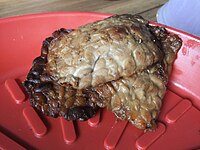Javanese cuisine
This article needs additional citations for verification. (January 2024) |

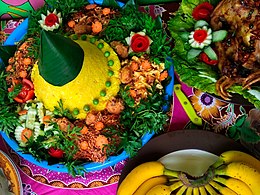 |
| This article is part of the series on |
| Indonesian cuisine Masakan Indonesia |
|---|
|
|
 |
| This article is part of the series on |
| Malaysian cuisine Masakan Malaysia |
|---|
|
|
Javanese cuisine (
.Definition
Javanese cuisine refers exclusively to the cuisine of Javanese people, which is often brought to other regions and countries by Javanese diaspora or foreign descents who have lived in Java.
There are several native ethnic groups who live on the island of Java (Sundanese, Madurese, Betawi, etc.) as well as other peoples of foreign descents. In Indonesian language, Javanese refers to people of Javanese ethnic background.
Javanese cuisine is thought to be sweet, since this is the taste traditionally preferred in Yogyakarta. However, Javanese regions do not only include Yogyakarta.
On the northern and northeastern of Central Java, for instance, the taste tend to be salty and spicy. In East Java, the level of spiciness increases. Today, as Javanese people become more mobile and may move to different regions, this typical stereotype of preferred regional tastes is outdated.

History
Ancient dishes and recipes were mentioned in numbers of Javanese prasasti (inscription) and modern historians have succeeded in deciphering some of them. The inscriptions from
In
Most of Javanese cuisine is natively developed. Many of the foods have been absorbed to modern Indonesian culture as "national dishes". Some of them have inspired many other regional dishes, such as, lontong (Jav. Lonthong), tumpeng, krupuk, jajan pasar, and many more.
Foreign influences on Javanese food can be seen in some food, such as bakmi and fried rice (Chinese), sate (Arab) and kari (Indian).
Ingredients


Outlets
Javanese households usually purchase fresh ingredients from the local market every morning, cook and serve them in the late morning to be mainly consumed for lunch. The leftovers are stored to be heated again for family dinner. Other than homemade family dishes, Javanese cuisine are served from humble street-side carts and
In Javanese tradition, it is common to dine in lesehan style, which is sitting cross-legged on the mat while dining in front of a short-legged table. It was started as a warung lesehan street food dining popular among tourists along
- Javanese cuisine outlets
-
Food display in warung Tegal.
-
Street-side Javanese chicken satay vendor near Borobudur.
-
Lesehan sit on the mat dining at Malioboro street, Yogyakarta.
-
Angkringan food stall.
Central Javanese cuisine
The food in
Semarang

- Bandeng Juwana: processed tender boned milkfish originated from the fishing town of Juwana, east of Semarang. Although originated, produced and processed in Juwana, it is largely sold in Semarang.
- Lumpia Semarang: fried or steamed spring rolls. The filling varies, but consists mainly of meat and bamboo shoots. It is served with sweet fermented soybean sauce (tauco) or sweet garlic sauce. Another accompaniment is acar (Indonesian-style sweet and sour cucumber pickle) and chili.
- Nasi ayam: a dish composed of rice, chicken, egg, tofu, and served with a sweet-salty coconut milk gravy.
- Roti ganjel rel, rectangular shaped brown bread with sesame seeds, flavored with cinnamon and palm sugar. Usually served during Dugderan and Ramadan.
- Soto Semarang: a chicken soup in a small personal serving; mixed with rice, perkedel, and satay of cockles, chicken intestines, and quail eggs. One of the famous Soto Semarang is Soto Bangkong. Named after Bangkong crossroad in Semarang.
- Wingko Babat: a cake made largely of glutinous rice and desiccated coconut, toasted and sold warm. Although it originated from Babat, East Java, it is popular in Semarang. Care should be taken to differentiate between Babat and babat. Babat is a city in East Java, part of the North Coast Road and where wingko Babat came from, while babat is tripe, an ingredient often used for Indonesian cuisine in general.
Jepara

- Soto Jepara: soto is a common Indonesian soup, usually infused with turmeric, and can be made with chicken, beef, or mutton. The version from Jepara, a Central Javanese town, is made of chicken.
- Opor panggang: a typical opor from Jepara. It is a kind of opor ayam but with distinctive flavor, since the chicken used in this dish is first roasted in a clay cauldron.
- Kuluban: traditional salad from Jepara Regency.
- Kelap antep: dish made from lean meat, ginger, bay leaves, red onion, garlic, red chili, tamarind, sugar, and others.
- Horok-horok: steamed corn starch. After being cooked, corn starch is then poured into jars and stirred with a comb. So although chewy and tough, it is shaped in small granules resembling Styrofoam. To add flavor, a pinch of salt can be added. This dish can be served as an accompaniment to meatballs, gado-gado, pecel, or satay kikil (beef tendon).
- Hoyok-hoyok: also called oyol-oyol, is a dish made from tapioca flour mixed with water and oil, then served with extra grated coconut. Hoyok-hoyok is a sweet version of horok-horok.
- Jepara shrimp soup: similar to shrimp soup in general. This version of soup use shrimp broth and fried shrimp, also raw crushed chili. This soup is delicious eaten while still hot or warm.
- Jepara pangsit soup: considered as a fusion cuisine, this dish is a blend of local and foreign cuisines, i.e. Javanese, Dutch, and Chinese. The pangsit (dumpling) in this soup is not like the dumpling we know, but rather in the form of a clear soup with shrimp egg rolls. This is one of the favorite dishes of R.A. Kartini.
- Bongko mento: originated in Jepara palace, it is a snack wrapped in a banana leaf. Consists of omelet filled with sauteed shredded chicken breast mixed with oyster mushrooms, glass noodles, and coconut milk.
- Lontong krubyuk: similar to lontong dishes in general, this dish consists of rice cake served with shredded chicken meat stews doused in bakso soup and garnished with a mixture of half-cooked bean sprouts and sliced celery. What distinguishes this from other lontong dishes, this dish is served with a lot of soup.
- Singit: beef shank cooked in coconut milk, soy sauce, salt, red chili, garlic, onion, and brown sugar, over low heat until the sauce thickens.
- Semur Jepara: made of meat, salt, pepper, nutmeg powder, soy sauce, cooking oil, and others.
- Sayur pepaya Jepara: a vegetable stew usually served in the afternoon. The main ingredients are young papaya, coconut milk, beef stew, and others.
- Sayur asem Jepara: similar to sayur asem Jakarta.
- Sayur betik: a vegetable stew, using young unripe papaya and beef trimming as the main ingredients.
- Gule petih Jepara: made of tender goat meat and spice mixture. Usually served during Eid al-Fitr and Eid al-Adha.
- Laksa Jepara: made of chicken fillet, banana shrimp, chicken stock, coconut milk, lemongrass, kaffir lime leaves, salt, sugar, oil, and other ingredients.
- Sayur keluak ayam: made of vegetables, keluakand chicken.
- Kagape kambing: a dish made of goat meat. Easily found during Eid al-Adha.
- Bakso Karimunjawa: meatballs soup made from fish, instead of beef or chicken.
- Tongseng cumi: tongseng made of calamari or squid, instead of goat or chicken.
- Rempah Jepara: a dish made from grated coconut, fish, and others.
- Bontosan: a dish of mashed grouper or mackerel mixed with rice powder and shaped into spindles, wrapped in banana leaves or plastic, steamed, then thickly sliced, and served with sauce or gravy. Bontosan is actually the pre-dried form of fish crackers. It can also be served after being shallow-fried until the outside is crisp and golden brown. Similar in taste to pempek.
- Sate sapi Jepara: satay made of cow meat mixed with spices typical of Jepara.
- Sate kikil: a satay dish made of kikil (beef tendon), also called satay cecek. Usually served with horok-horok.
- Pecel ikan laut panggang: roasted saltwater fish served with coconut milk sauce.
- Tempong: uncooked dried anchovy, shaped like fritter.
Kudus

- Jenang Kudus: A sweetmeat made from rice flour, palm sugar, and coconut milk.
- Opor bakar
- Soto Kudus: soto is a common Indonesian soup usually infused with turmeric, and can be made with chicken, beef, or mutton. The version from Kudus, a Central Javanese town, is made of chicken.
Pati
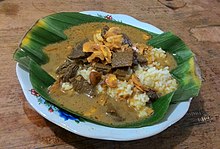
- Bandeng presto: is a pressure cooked milkfish that soften the finer fish bones. The pressure cooking also help the spices to seep into the flesh of milkfish perfectly.
- Nasi gandul: is beef served on white steamed rice poured with spicy savoury soup, served on banana leaf.
- Petis runting: is a kind of gulai typical culinary of Pati. Soupy but somewhat viscous, made from a rather coarse rice flour roasted with goat meat and balungan or goat bones, including bone marrows, and usually enjoyed while it hot to avoid the fatty bone marrow coagulating.
- Sayur mangut: is a hot and spicy Ariid catfish head cooked in coconut milk.
- Sayur tempe bosok: is a kind of curry-soup made from stinky over-ripe (almost rotten) tempeh. Popularly consumed during the rainy season against the cold.
- Soto kemiri: is a common Javanese chicken soup spiced with candlenut.
Yogyakarta
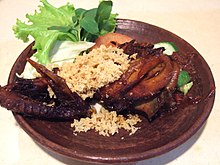

- Ayam geprek: crispy battered fried chicken crushed and mixed with hot and spicy sambal.[2]
- candlenut, and coconut water, then deep-fried until crispy. Served with sambaland raw vegetables.
- bakpia Pathokis sold.
- Belalang goreng: fried grasshopper dish.
- Brongkos: spicy meat and tolo beans (black-eyed peas) stew in coconut milk and kluwek soup with othert spices.
- jack fruit) boiled for several hours with palm sugar and coconut milk. This is usually accompanied by opor ayam (chicken in coconut milk), telur pindang (hard boiled egg stew), and krechek (spicy beef skin and tofu stew). Gudeg from Yogyakarta has a unique sweet and savory taste, and is drier and more reddish than other regional variants because of the addition of Javanese teakleaf.
- Kipo: derived from the Javanese question Iki opo? ("What is this?"), a small sweet snack from Kotagede made of glutinous rice flour and coconut milk dough filled with grated coconut and palm sugar.
- Krechek (also known as krecek or sambal goreng krechek): a traditional spicy beef skin dish made from seasoned krupuk kulit (beef skin crackers). Krechek is usually served as a side dish together with gudeg.
- Nasi kucing: rice with small side dishes.
Solo

- Bakso Solo: bakso literally means meatballs, made of beef, and served in boiling hot soup with mung bean-thread noodles, green vegetables, shredded cabbage, and various sauces (chili, tomato). This version from Solo has super-sized meatballs, the size of tennis balls. Also known as Bakso Tenis. Bakso is a Chinese-influenced dish, but has become a popular snack throughout Indonesia.
- Bistik Jawa: Javanese beef steak, a European-influenced dish from Solo.
- Nasi liwet: a rice dish cooked in coconut milk and chicken broth, served with meat and vegetable side dishes.
- Sate buntel (lit: wrapped satay): Minced fatty beef or goat meat, encased in caul fat and wrapped around a bamboo skewer then grilled. The size of this satay is quite large, very similar to a Middle Eastern kebab. After being grilled on charcoal, the meat is separated from the skewer, cut into bite-size chunks, then served in sweet soy sauce and merica (pepper).
- Selat Solo: a salad consisting of stewed beef, lettuce, carrot, green bean, and potato chips or French fries in sweet spiced dressing.
- Sosis solo, Javanese sausages made from beef or chicken and coated by egg.
- .
- Tongseng: a strongly spiced curry of bone-in mutton, which is quickly stir-fried at the point of sale with vegetables added.
- Tengkleng: goat ribs and offal in a curry-like soup, similar to gule kambing, but with a lighter and thinner soup.
- Timlo Solo: a beef and vegetable soup. Some versions also have noodles.[4]
Banyumas

Refers to Javanese cultural region of Western Central Java bordering West Java, including
.- Nasi bogana Tegal: a steamed rice dish wrapped in banana leaves and served with a variety of side dishes.
- Sate Tegal or Sate Balibul: juvenile (five-month-old) goat satay from Tegal, noted for its tender meat.
- Sate Ambal: a satay variant from Ambal, Kebumen, Central Java. This satay uses ayam kampung (free-range chicken). The sauce is not made from peanuts, but rather ground tempeh, chili, and spices. The chicken is marinated for about two hours to make the meat tastier. This satay is served with ketupat.
- Sroto Sokaraja: a variant of soto from Sokaraja, Banyumas.
- Tempeh mendoan: fried battered tempeh from Banyumas.
Other Central Javanese cuisine
- Bakmoy: small cubes of fried tofu, chicken, and boiled egg served with chicken broth and relish made from sweet soy sauce.
- Kamir: round-shaped bread that almost similar to apem, consisting of flour, butter, and egg mixture.
- Krechek: spicy stew made from skin cracker, potato and soy beans.
- Mie kopyok (lit. shaked noodles): a noodle soup made of garlic broth, rice cake, fried tofu, and rice cracker.
- Mie ongklok: boiled noodles were made using cabbage, chunks of chopped leaves, and starchy thick soup called loh. Usually served with satay and tempeh.
- Nasi megono, rice dish with chopped young jackfruit mixed with coconut and other spices.
- Blora: chicken satay from Blora area.
- Sop senerek, traditional soup from Magelang with beef, red bean, carrot, tomato, celery, and fried shallots.
- Purwodadi: frogs' legs cooked in fermented soybean (tauco) soup.
East Javanese cuisine
The East Javanese cuisine is largely influenced by
Madiun

- Brem Madiun: fermented sugar and cassava cakes.
- Pecel Madiun: a salad of boiled vegetables, dressed in a peanut-based spicy sauce. It is usually served as an accompaniment to rice. A peanut or dried fish/shrimp cracker (rempeyek) is served on the side. Not to be confused with pecel lele, which is deep-fried local catfish served with sambal.
Lamongan
- Ayam penyet: fried chicken (see ayam goreng), lightly smashed using a pestle in a mortar laced with sambal.
- Bebek goreng: deep fried duck, similar to duck confit.
- Pecel lele: deep fried catfish with sambal, vegetables, and rice.
- Lamongan: chicken soup originated from the town of Lamongan.
- petis-based beef stew.
Surabaya

- Ayam penyet: "smashed chicken", fried chicken that is smashed with the pestle against mortar to make it softer, served with sambal, slices of cucumbers, fried tofu and tempeh.
- Lontong kupang: lontong with small cockles in petis sauce.
- Rawon Surabaya: a dark beef soup, served with mung bean sprouts and the ubiquitous sambal. The dark (almost black) color comes from the kluwak (Pangium edule) nuts.
- .
- Semanggi: a salad made of boiled semanggi (M. crenata) leaves that grow in paddy fields. It is dressed in a spicy peanut sauce.
Madura
- candlenut, and salt. Chicken Madura satay is usually served in peanut sauce, while the mutton Madura satay is usually served in sweet soy sauce. Sate Madura uses smaller chunks of meat than other variants. It is eaten with rice or rice cakes wrapped in banana/coconut leaves (lontong/ketupat). Raw thinly sliced shallots and plain sambal are often served as condiments.
- .
Malang

- Bakso Malang: bakso literally means meatball. Bakso Malang has more accompaniments, beside the meatball (mostly beef) itself. For example, offal, siomay dumplings (fried or steamed), tahu (tofu, fried or steamed, filled with meat), sound (mung bean threads), and yellow egg noodles. All of these are served in hot beef stock.
- Cwie mi: a Chinese-influenced noodle dish, containing boiled and seasoned noodles, topped with pre-cooked minced meat (usually zhajiang mian.
Banyuwangi
- Bolu klemben: cake with tortoise-like shape, made of mixture of flour, eggs, and sugar.
- Botok tawon: a type of botok that made from bee larvae.
- Pelasan, Osing-style of pepes food. The popular Osing pepes are pelasan teri, pelasan tahu and pelasan ayam.
- Pindang koyong: a fish cooked in yellow gravy-like soto with various spices.
- keluaknuts.
- Rujak soto: a unique blend of vegetable salad with soto, it can be soto daging (beef) or soto babat.
- Sale pisang: bananaswhich are combed thin and then dried in the sun. After dried in the sun, it can be directly eaten or fried first.
Other East Javanese cuisine

- Kare rajungan: curry dish cooked using portunidae.
- Lontong balap: literally means "racing rice cake", which is a dish of rice cakes, fried tofu, and beansprouts, doused in kecap manis and sambalsauce. In the past, lontong balap hawkers carried their wares in a large, heavy metal urn. The heaviness caused them to have to walk really quickly while carrying it, so they looked like they were "racing".
- Madumongso: a sweetmeat made from fermented black glutinous rice, cooked in coconut milk and sugar. It is sticky and very sweet, and comes wrapped in corn husk.
- Roti konde: a type of roti canai. Their recipes are quite similar and influenced by Indian paratha.
- Sate Ponorogo: a variant of Ponorogo, a town in East Java. It is made from sliced marinated chicken, served with a sauce made of peanuts and chili, and garnished with shredded shallots, sambal, and lime juice. This variant is unique for the fact that each skewer contains one large piece of chicken, rather than several small cubes. The meat is marinated in spices and sweet soy sauce, in a process called "bacem" and is served with rice or lontong (rice cake). The grill is made from terracottaearthenware with a hole on one side to allow ventilation for the coals. After three months of use, the earthenware grill disintegrates and must be replaced.
- petis) which is mixed in just before serving.
- Tahu tek-tek: a dish containing cut-up fried petis), chili, and garlic.
Common Javanese dishes
These are the common Javanese dishes, which can be found throughout Java regardless of the location.
- Apem, traditional cake of steamed dough made of rice flour, coconut milk, yeast and palm sugar, usually served with grated coconut.[6]
- Ayam bumbu rujak, chicken dish made from chicken meat which is still young and uses a red basic spice then grilled. A red base is a spice made from salt, garlic, onion, and red chili.
- Ayam goreng, fried chicken dish consisting of chicken deep fried in oil with various spices.[7]
- Ayam kecap, chicken simmered or braised in sweet soy sauce.
- Bakmi jawa, wheat based noodle, generally prepared and topped with minced chicken seasoned in soy sauce, green vegetables and a bowl of broth.
- Bakso, bakso literally means meatball. Beef or chicken meatballs, usually served in a bowl of broth with yellow noodles, rice vermicelli, vegetables, tofu, green cabbage, bean sprout, sprinkled with fried shallots and celery.
- gorengan.
- Bergedel, fried patties, made of ground potatoes, minced meat, peeled and ground corn or tofu, or minced fish.
- Bergedel jagung, corn fritters.
- Botok, a dish made from shredded coconut flesh which has been squeezed of its coconut milk, often mixed with other ingredients such as vegetable or fish, and wrapped in banana leaf and steamed.
- Brengkesan, fish, meat, tofu, anchovy or mushroom ingredients cooked inside a banana-leaf package.
- Bubur ayam, rice congee with shredded chicken meat served with some condiments and cake.
- Bubur kacang hijau, sweet dessert made from mung beans porridge with coconut milk and palm sugar or cane sugar. The beans are boiled till soft, and sugar and coconut milk are added.
- Bubur ketan hitam, sweet dessert made from black glutinous rice porridge with coconut milk and palm sugar or cane sugar. The black glutinous rice are boiled until soft, and sugar and coconut milk are added.
- Bubur sumsum, white congee made from rice flour and eaten with brown sugar sauce.
- Buntil, a traditional Javanese dish of scraped coconut meat mixed with anchovies and spices, wrapped in a papaya leaf, then boiled in coconut milk.
- water spinach.
- Dawet, an iced sweet dessert that contains droplets of green rice flour jelly, coconut milk and palm sugar syrup.
- Donat jawa, Javanese-style of ring-shaped fritter made from cassava with savoury taste.
- Garang asem, chicken dish cooked using banana leaves and dominated by sour and spicy flavor.
- Gorengan, assorted fritters such as tempeh, tofu, yam, sweet potato, cassava, and chopped vegetables.
- Gule, a type of soupy curry-like dishes that could be made from various ingredients; meats, fish or vegetables. The gule that popular in Javanese cuisine both are gule kambing (made of goat or mutton) and gule ayam (made of chicken).
- Gule ayam, chicken cooked in a curry-like coconut milk soup.
- Gule kambing, mutton cooked in a curry-like coconut milk soup.
- Iga penyet (lit. squeeze ribs), fried beef spare ribs served with spicy sambal terasi. The fried beef ribs is squeezed against a mortar filled with sambal, and usually served with lalab vegetables and steamed rice.
- Ikan asin, salted and sun-dried fishes of various species.
- Kare, the Javanese adaptation of curry dishes. Just like gulai, it could be made from various ingredients; meats or vegetables.
- Klepon, glutinous rice balls stuffed with palm sugar, colored green using pandanus leaf, and rolled in fresh grated coconut.
- Keripik tempe, tempeh chips, made from thinly sliced, lightly battered, then deep fried tempeh (soybean cake).
- Kupat, rice dumpling made from rice packed inside a diamond-shaped container of woven palm leaf pouch.
- Kwetiau ayam, boiled flat noodle with diced chicken.
- Kwetiau goreng, stir fried flat noodle dish.
- palm leaf.
- Lontong, pressed rice cake inside banana wrapping.
- Lumpia, spring roll made of thin paper-like or crepe-like pastry skin called "lumpia wrapper" enveloping savory or sweet fillings.
- Lotek, almost identical to gado-gado, but sweeter. It is similar to pecel, but includes different vegetables as well as boiled egg slices and a garnish of fish or shrimp crackers and emping (Gnetum gnemon L. nut, flattened, dried, and fried into small thin crackers).
- Martabak, stuffed pancake or pan-fried bread, sometimes filled with beef and scallions. Usually served with sambals and acar.
- Mie ayam, chicken bakmi dish of seasoned yellow wheat noodles topped with diced chicken meat.
- Mie bakso, bakso served with yellow noodles and rice vermicelli
- Mie goreng, spicy fried noodle dish seasoned in sweet soy sauce. The popular one is mie goreng jawa.
- Mie pangsit, noodle soup dish served with soft-boiled wonton.
- Mie rebus, famous noodle dish which consists of noodles, salt and egg, served with a tangy, spicy and sweet potato-based sauce.
- .
- Nasi goreng (lit. fried rice), Javanese-style of Indonesian fried rice.
- Nasi goreng jawa, fried rice dish uses sambal ulek as seasoning and has a spicy taste.
- , curry, acar, fried shallots and sambals.
- nasi rames or nasi campur, but the rice is cooked in coconut milk and colored bright yellow using turmericand scented with lemongrass and kaffir lime leaves.
- Nasi rames, rice with accompaniments, usually some curried vegetable stew (sayur lodeh), a selection of cooked fish or chicken or meat and offal pieces, and a dollop of spicy sambal.
- Pangsit, wonton filled with vegetables, chicken or shrimp. It can be dry or wet.
- Petis, black-colored shrimp paste.
- pandan leaf, filled with palm sugar, and steamed in bamboo tubes, hence its name, and served with grated coconut.
- Puyonghai, omelette dish made from the mixture of vegetables such as carrots, bean sprouts, and cabbages, mixed with meats such as crab meat, shrimp, or minced chicken.
- Rempeyek, deep-fried savoury Javanese cracker made from flour (usually rice flour) with other ingredients, bound or coated by crispy flour batter. The most common type of rempeyek is peanut peyek.
- Rengginang, thick rice cracker, made from cooked glutinous sticky rice and seasoned with spices, made into a flat and rounded shape, and then sun-dried. The sun-dried rengginang is deep fried with ample cooking oil to produce a crispy rice cracker.
- jam.
- Rujak, traditional fruit and vegetable salad dish. There are many kinds of rujak.
- Sambal, chili sauce or paste typically made from a mixture of a variety of chili peppers with secondary ingredients such as shrimp paste, garlic, ginger, shallot, scallion, palm sugar, and lime juice. Sambal has many various types.
- Satay, skewered grilled meat is a common dish in Java. The Javanese variants are sate Tegal, sate Ambal, sate Solo, sate buntel, sate Madura, sate Ponorogo, etc.
- temu kunci.
- Sayur lodeh, assorted vegetables, stewed in coconut milk.
- Serabi, rice pancake that is made from rice flour with coconut milk or shredded coconut as an emulsifier.
- Sop buntut, oxtail soup.
- Soto, this Indonesian soup dish is also a common dish in Java. The Javanese variants are common soto ayam and soto babat (tripe), soto Kudus, soto Madura, soto Lamongan, etc.
- Tahu, fermented soy food basically a soy milk cheese. It can be fried, stir fried, stewed, as soup ingredient, even also for sweets.
- Tahu goreng, deep fried tofu prepared with some condiments, such as shrimp paste, sambal, fried shallots, mayonnaise or soy sauce.
- Tapai, traditional fermented preparation of rice or other starchy foods.
- Telur pindang, marbled eggs boiled with herbs and spices.
- vegetarians.
- Tempe bacem, stewedin coconut sugar and spices, then deep-fried. It has sweet and savoury flavour.
- Tempeh burger, hamburger with tempeh as main ingredient, a Javanese fusion dish.
- Tempe penyet, fried tempeh mixed with sambal chili paste in a mortar and pestle. Usually served in addition to other penyet dishes, such as ayam penyet (chicken) or iga penyet (ribs).
- Tempe bacem,
- Terang bulan, bread like puff with sugar, corn, and coarse nut in the middle.
- Tiwul, boiled rice substitution made from dried cassava.
- Tumis sayuran, stir-fried vegetables, usually mixed with chili and a spice paste.
- Tumpeng, a rice served in the shape of a conical volcano,[14] usually with rice colored yellow using turmeric. It is an important part of ceremony in Java. Tumpeng served in important events such as birthday, moving house, or other ceremonies.[15] Traditionally, tumpeng is served alongside fried chicken, boiled egg, vegetables, and goat meat on a round plate made from bamboo called besek.
- Untir-untir, dough twist that is fried in peanut oil. It has a shiny and golden look with crispy taste.
- Urap sayur, vegetables in spiced grated coconut dressing.
- Jajan pasar, several types of shaped and colored flour, rice flour, and glutinous rice flour cakes, sprinkled with desiccated coconut and drizzled with melted palm sugar. Jajan literally means snack, and pasar means market, as this snack is usually found in traditional markets.
Javanese beverages

- Dawet, green rice flour jellies served with gula jawa (palm sugar), santen (coconut milk) and ice.
- Es asem or gula asem, tamarind juice with gula jawa (palm sugar) and ice.
- Teh poci Tegal: tea brewed in a clay teapot, served with rock sugar. Tegal, a Central Java town, is a major producer of high-quality tea.
- Wedhang ronde (ronde): a hot Javanese dessert of glutinous rice balls stuffed with peanut paste, floating in a hot and sweet ginger and lemongrass tea.
- Wedhang angsle (angsle): a hot soupy dessert of sago pearls, pre-cooked glutinous rice and mung beans, putu mayang (brightly colored, noodle-shaped flour cakes), and fried peanuts, covered in hot and sweet coconut milk.
- Wedhang uwuh (uwuh) (id): a hot Javanese clove drink.
See also

Notes
- ^ "Hanya Ada Di Candi Sojiwan: Menu Hidangan Raja Mataram Kuno". TEMPO.CO (in Indonesian). 22 February 2017.
- ^ "Three places to enjoy fiery hot 'ayam geprek'". The Jakarta Post. Retrieved 30 December 2019.
- ISBN 9789790061668.
- ISBN 978-1-74220-348-5. Retrieved 30 January 2015.
- ISBN 978-979-223923-2.
- ^ "Kue Apem Kukus" (in Indonesian). Sajian Sedap. 16 December 2010. Retrieved 25 June 2015.
- ISBN 978-1-60774-725-3.
- ^ No Money, No Honey: A study of street traders and prostitutes in Jakarta by Alison Murray. Oxford University Press, 1992. Glossary page xi
- ISBN 9781317636229.
- ^ Wibisono Notodirdjo (7 August 2011). "Sweet treats from the past". The Jakarta Post. Jakarta.
- ISBN 978-1-74059-154-6.
- ISBN 978-979-934179-2.
- ISBN 9789792244519.
- ISBN 978-1-920942-34-2.
- ISBN 978-0-7112-1273-2.

